
About UsThe Numismatic Bibliomania Society is a non-profit organization promoting numismatic literature. For more information please see our web site at coinbooks.org SubscriptionsThose wishing to become new E-Sylum subscribers (or wishing to Unsubscribe) can go to the following web page link MembershipThere is a membership application available on the web site Membership Application To join, print the application and return it with your check to the address printed on the application. Membership is only $15 to addresses in the U.S., $20 for First Class mail, and $25 elsewhere. For those without web access, write to: David M. Sundman, Secretary/TreasurerNumismatic Bibliomania
Society AsylumFor Asylum mailing address changes and other membership questions, contact David at this email address: dsundman@LittletonCoin.com SubmissionsTo submit items for publication in The E-Sylum, just Reply to this message, or write to the Editor at this address: whomren@coinlibrary.com
BUY THE BOOK BEFORE THE COINYou won't regret it! |
- WAYNE'S WORDS: THE E-SYLUM APRIL 26, 2009
- COINBOOKS.ORG REVAMPED: NEW NUMISMATIC BIBLIOMANIA SOCIETY WEB SITE UNVEILED
- LAKE BOOKS 98TH NUMISMATIC LITERATURE SALE CLOSES MAY 26, 2009
- DAVID F. FANNING NUMISMATIC LITERATURE SALE CLOSES JUNE 4, 2009
- GEORGE KOLBE NUMISMATIC LITERATURE SALE #110 CLOSES JUNE 11, 2009
- DAVID SKLOW NUMISMATIC LITERATURE SALE #7 CLOSES JUNE 13, 2009
- NEW BOOK: JOHN J. FORD, JR. AND THE “FRANKLIN HOARD”
- NEW BOOK: NEWBY'S ST. PATRICK COINAGE
- NEW EDITION: THE NEIGHBORHOOD MINT: DAHLONEGA IN THE AGE OF JACKSON
- NEW EDITION: FRIEDBERG'S GOLD COINS OF THE WORLD, 8TH EDITION
- NEW BOOK: SEA SERVICE MEDALS BY FRED BORCH
- NEW E-BOOK: COMPLETE GUIDE TO BARBER DIMES BY DAVID LAWRENCE
- REVIEW: COIN WORLD'S ONLINE EDITION
- THOUGHTS ON THE MOTTO 'IN GOD IS OUR TRUST'
- VOCABULARY WORD: MORE ON BRUMAGEM OR BRUMMAGEM
- MORE ON THE OMAHA BANK HOARD
- MORE ON RELIC MEDALS
- MORE ON THE GREAT DEPRECIATION
- MISTER RED BOOK: RICHARD S. YEO
- NUMISMATICS IN STEPHEN KING'S "SKELETON CREW"
- QUERY: RESEARCH ON OREGON AND OTHER STATE CENTENNIAL MEDALS SOUGHT
- 2009 HUDSON-FULTON CELEBRATION LACKS MEDALS
- MORE ON NUMISMATIC TRAINING FOR BANK TELLERS
- QUERY: ANDREW AND GEORGE ZABRISKIE
- NUMISMATIC LITERATURE AND PROJECT GUTENBERG
- ANCIENT MANUSCRIPTS PLACED ONLINE
- ARTICLE PROFILES U.S. MINT DESIGNER SUSAN GAMBLE
- WELSHMAN RICHARD WILLIAMS AND HIS BLACK SHEEP BANK NOTES
- MORE ON DETROIT'S LOCAL CURRENCY
- DOG'S 1945 DICKIN MEDAL SOLD AT AUCTION
- A DOG NAMED BANKNOTE
- THIEVES ROB BANK OF FAKE MONEY
- FEATURED WEB PAGE: HOW TO PACK BOOKS
WAYNE'S WORDS: THE E-SYLUM APRIL 26, 2009
 Among our recent subscribers are Brenda Colladay, Frank Rooster, Tom Dalrymple, Mike Ivester, J. C. Spilman and Brad Higgins. We now have 1,233 subscribers.
Among our recent subscribers are Brenda Colladay, Frank Rooster, Tom Dalrymple, Mike Ivester, J. C. Spilman and Brad Higgins. We now have 1,233 subscribers. This week we open with the announcement of a new version of the NBS web site, followed by news from several of our numismatic literature dealer friends. New books discussed this week cover topics including John J. Ford, Jr., the Dahlonega Mint, gold coins of the world, sea service medals, and Mark Newby's St. Patrick coins.
Other topics include the Omaha Bank Hoard, relic medals, centennial medals, and U.S. Mint designer Susan Gamble. To learn what Prif Trysorfa Cymru Limited has to do with numismatics, read on. Have a great week, everyone!
Wayne Homren
Numismatic Bibliomania Society
COINBOOKS.ORG REVAMPED: NEW NUMISMATIC BIBLIOMANIA SOCIETY WEB SITE UNVEILED
Many months in the making, the new web site for our organization has been rolled out to the Internet. It now has a look and feel modeled after the new graphic version of The E-Sylum.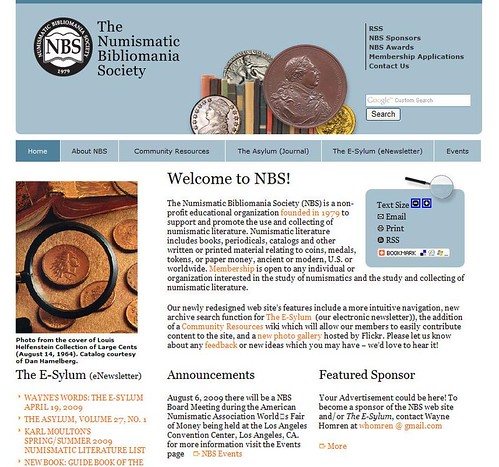
www.coinbooks.org
Actually, it was the web site redesign that came first, but due to some delays the newsletter was launched first. Most of the credit belongs to Bruce Perdue, who devoted many volunteer hours to porting over our old content to the new format.
Thanks also to the NBS board, which last year authorized a large expenditure to commission a design firm to create the templates for the site. And as always, thanks also go to John Nebel who hosts the site for free on his servers; he and Susie Nulty devoted time as well to install the Wiki and update various templates and programs.
The Wiki is a section of the site devoted to member-supplied content. Here is where you'll find the NBS Numismatic Bibliography, a discussion of numismatic literature types, numismatic research projects and links to other noncommercial numismatic web sites. Contributions are welcomed and encouraged.
The site has all the information you'd expect to find for an organization like ours - our constitution & bylaws, club history, officers, contact information, membership applications, club events, awards, etc. There is information about our print journal, The Asylum, and a complete archive of all back issues of The E-Sylum, over 10,000 pages in all.
But wait, there's more... there are also links to our E-Sylum Flickr image library (over 1,200 pictures and growing weekly), and a new way to subscribe to The E-Sylum - the RSS feed. You can also bookmark and share the NBS web site on your Facebook, LinkedIn or Twitter pages.
Lastly, the new site includes rate sheets for advertising. Hundreds of hours and thousands of dollars have gone into this revamped site, and we hope the numismatic community will show its support, even in these difficult economic times.
There are ad plans of all shapes, sizes and costs. Numismatic literature dealers, book publishers, coin dealers, clubs and individuals are all welcome. See www.coinbooks.org/sponsors/sponsor_info.html .
Comments and suggestions are welcome. Please give it a test run and let us know what you think. To access the Numismatic Bibliomania Society web site, see:
www.coinbooks.org
LAKE BOOKS 98TH NUMISMATIC LITERATURE SALE CLOSES MAY 26, 2009
Lake Books
6822 22nd Ave N.
St. Petersburg, FL 33710
(727) 343-8055 FAX:(727) 345-3750
DAVID F. FANNING NUMISMATIC LITERATURE SALE CLOSES JUNE 4, 2009
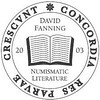 David F. Fanning Numismatic Literature have announced that the catalogue for their upcoming mail-bid auction, closing June 4, is now available on their Web site at www.fanningbooks.com. The catalogue can be downloaded (sans covers and color plates) as a PDF.
David F. Fanning Numismatic Literature have announced that the catalogue for their upcoming mail-bid auction, closing June 4, is now available on their Web site at www.fanningbooks.com. The catalogue can be downloaded (sans covers and color plates) as a PDF. The hard-copy catalogues will mail in the next couple weeks or so. To request a hard-copy catalogue, contact David Fanning at dfanning@columbus.rr.com.
The online catalogue includes some additional illustrations in the text and can be searched by keywords, which is a very convenient and easy way to find what you're looking for (though the catalogue is also indexed). Additional information is available at www.fanningbooks.com .
GEORGE KOLBE NUMISMATIC LITERATURE SALE #110 CLOSES JUNE 11, 2009
Copies of the catalogue may be obtained by sending $15.00 to George Frederick Kolbe, P. O. Drawer 3100, Crestline, CA 92325. Telephone: (909) 338-6527; Fax: (909) 338-6980; Email: GFK@numislit.com. The catalogue will also be accessible free of charge several weeks before the sale at the firm's web site: www.numislit.com.
The third and last part of the Bassoli library features classic works on Italian numismatics and early printed numismatic books. The third and last part of the Twinleaf library features important works on American numismatics, particularly key works on large cents. Also featured is a fine selection of works on Serbian numismatics, a number of classic, multi-volume works on ancient Greek and Roman coins, and long runs of classic nineteenth and twentieth century American auction sale catalogues.
Some highlights follow: early Q. David Bowers publications, including the first three issues of Rare Coin Review; the very rare original Frenkenhuis catalogue of World War I medals; the first work on Civil War Tokens, published in 1863, documenting that the 303 tokens listed did indeed circulate contemporaneously; an extremely rare and extensive illustrated guide to counterfeit and genuine world banknotes issued in the 1980s and 1990s by the National Bank of Yugoslavia; a rare 1880s William von Bergen publication featuring contemporary information on the Adolph Weyl 1804 Dollar sold by the Chapman brothers;
Charles Chaplin’s delightful 1865 “Gointoem Strong” spoof on American coin sales of the day; a presentation set of Loubat’s classic Medallic History of the United States; a unique notebook on ancient Greek coins written by Sawyer McArthur Mosser; an interesting archive of over sixty letters written to John A. Muscalus, mainly devoted to various aspects of obsolete American paper currency; several coin sales not listed in Gengerke; a near new set of Haxby’s four volume work on obsolete bank notes; an exceptionally fine set of Davenport works on world crowns; a fine set of Pridmore on British colonial coins;
Jem Sultan’s own set of his two volume work on Ottoman coins; a complete set of Sylloge of Coins of the British Isles Volumes 1-59, 1958-2007; the first 192 Stack’s auction sale catalogues, 1935-1964, lacking only three sales; a fine original edition of Hickcox’s 1858 Historical Account of American Coinage, the first substantial work on the topic, limited to only 200 copies; fine examples of the original, superbly illustrated, 1887 and 1896 classic Rollin & Feuardent catalogues of the Ponton d’Amécourt and H. Montagu collections of Roman gold coins; and fine sets of the classic Cohen (8 volumes) and Mazzini (5 volumes) works on Ancient Roman coins, both from the library of the celebrated numismatist Dr. Pierre Bastien.
DAVID SKLOW NUMISMATIC LITERATURE SALE #7 CLOSES JUNE 13, 2009
Catalogs available by request; Send inquiries to: David Sklow-Fine Numismatic Books, P. O. Box 6321, Colorado Springs, CO 80934. Telephone: (719)-302-5686; Fax: (719)-302-4933; Email: numismaticbooks@aol.com. The catalog is currently accessible on-line: www.finenumismaticbooks.com Bids will be accepted by, telephone, fax, email and regular mail.
Several sale highlights: The Estate Numismatic Library of a Connecticut Bibliophile; Myron Xenos Personal Library of United States Copper Related Literature; The Personal Library of a Former Numismatic Literature Publisher and Dealer; Memorabilia From Laurese Katen; Several other Consignments:
- Lot-24- Deluxe Leather Bound A Register of Half Dollar Die Varieties and Sub-Varieties by Beistle.
- Lot-58- Deluxe Half Morocco #24 of 100 California Pioneer Fractional Gold by Breen & Gillio.
- Lot-126- Special Interleaved Second Edition United States Pattern, Experimental and Trial Pieces by Judd.
- Lot-155-Deluxe Full Morocco (thin paper) United States Copper Cents by Newcomb
- Lot-145-Numbered Edition # 3 of California Gold: Quarters, Halves, Dollars by Ed Lee (Howard Newcomb’s Copy)
- Lot-176-Deluxe Leather Bound Private Gold Coins Struck in the United States 1830-1861 by Wayte Raymond
- Lot-196-Deluxe Quarter Leather Numbered 12 of 25 Bust Half Fever 1807-1836 by Edgar Souders
- Lots- 212 & 213- Original Numbered Fractional Currency by Valentine
- Lot-225- Deluxe Full Leather Numbered 4 of 25 Gold Coins of the Dahlonega Mint by Winter
- Lot-238- Limited Numbered 82 of 182 Photographic Plates: State Copper Coinage The Taylor Collection
- Lot-240-The United States Cents of the Year 1794 by Chapman
- Lot-242- The United States Cents of the Years 1798-1799 by Clapp
- Lot -243-The United States Cents of 1795, 1796, 1797 & 1800 by Clapp & Newcomb
- Lot-248- A “NOVA CONSTELLATIO” Crosby, Early Coins of America………
- Lot-287-The United States Cents of 1801-02-03 with “2” Supplemental plates by Newcomb
- Lots 328 & 329- Special Inventory Annotated U.S. Numismatic Literature by Adams
- Lots-341-356- The Complete Deluxe Leather Bound Auction Sales of Remy Bourne
- Lots-374-407- Deluxe and Limited Editions of Volumes by Remy Bourne on Fixed Price Lists & Periodicals
- Lot- 415-Deluxe Leather Bound Numbered # 4 of 14 A Pictorial Album of The Invasion of Louisville
- Lot-418- Deluxe Two Volume Set of Dalton & Hamer on Conder Tokens
- Lot-460- Nearly Complete Set of Auction Sales (119) by Sam Kabealo
- Lot-711- Deluxe Full Morocco (thick paper) United States Copper Cents by Newcomb
- A nearly Complete Set of Frank Katen Auction Sales 1-84; lacking # 4
- Runs of Auctions Sales by James Kelly, Paul Seitz, Walter Webb
- Many deluxe editions of publications by The Money Tree (Myron Xenos & Ken Lowe)
- Run of Gengerke American Numismatic Auctions Inventory Copies
- Several Very Rare Photographs of Frank Katen
- Set of Original Plates of Frossard’s 1878 Monograph on U.S. Cents & Half Cents
- Set of The Asylum
THE BOOK BAZARRE
NEW BOOK: JOHN J. FORD, JR. AND THE “FRANKLIN HOARD”
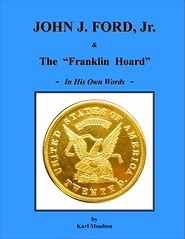 Over 20 years of research went into piecing together the real story of how John Ford marketed numerous Pioneer and Territorial pieces that were reportedly “discovered” by Paul Franklin in the 1950s. Other “Franklin Hoard” items that have been marketed in the past 60 years are examined in detail in an attempt to validate authenticity from the 19th century, as has been claimed.
Over 20 years of research went into piecing together the real story of how John Ford marketed numerous Pioneer and Territorial pieces that were reportedly “discovered” by Paul Franklin in the 1950s. Other “Franklin Hoard” items that have been marketed in the past 60 years are examined in detail in an attempt to validate authenticity from the 19th century, as has been claimed.John Ford was intelligent and ambitious. He told many stories, and the people loved them. Trouble is, there were different versions of the same story told at different times. Was he a counterfeiter? No. Was he duped by Paul Franklin? No. Was he an honest authenticator? No.
Previous commendable attempts to uncover the reality of Ford’s numismatic activities have been only partly successful and correct. There were never any source materials available to help validate what was done regarding the “Franklin Hoard”. Now there are. This work includes copies of nearly 200 personal letters from Ford during the 1950s when the first group of “Franklin Hoard” material was being sold. Additional “Franklin Hoard” developments are chronicled through 2008.
Other bits and pieces from numerous, little known sources were compiled from public records to present this “reality research” about Ford from when he first became interested in numismatics as a teen-ager in the 1930s until his death in 2005.
John J. Ford, Jr., was the most controversial figure ever to appear in American numismatics. His collection, when sold by Stack’s, realized over $55 million. This unbiased account explains in detail that which you never knew about Ford. It is truly a fascinating story!
Until now, the “Franklin Hoard” story always stopped with Paul Gerow Franklin. Until now, the all important identification of Franklin’s sources has never been presented. Until now, the material that makes up the “Franklin Hoard” (1952-1981) has never been defined and/or listed as such.
This book is not for everyone; but, if you ever wanted to know more about John J. Ford, Jr. or the “Franklin Hoard”, this book is the one you should have.
250 numbered copies will be printed and sold by subscription only. It will be available in the fall of 2009 at a price of $395 ppd.
For orders or inquiries, please contact: numiscats@aol.com
Karl Moulton, PO Box 1073, Congress, AZ 85332
I was pleased to have gotten to know John Ford and had several nice talks with him over the years. He may or may not have been a rascal, but he certainly was a raconteur. I've also gotten to know well many of his detractors and other skeptics. We'll all be looking forward to Karl's book. -Editor
NEW BOOK: NEWBY'S ST. PATRICK COINAGE
 My copy of the proceedings of the 2006 American Numismatic Society Coinage of the Americas Conference (COAC) arrived this week. Held in New York November 11, 2006, the conference was on Newby's St. Patrick coinage. Edited by Oliver D. Hoover, the proceedings are a handsome dust-jacketed 333-page hardcover book.
My copy of the proceedings of the 2006 American Numismatic Society Coinage of the Americas Conference (COAC) arrived this week. Held in New York November 11, 2006, the conference was on Newby's St. Patrick coinage. Edited by Oliver D. Hoover, the proceedings are a handsome dust-jacketed 333-page hardcover book.Other new owners of the book commented in the Colonial Coin Yahoo group. Last Sunday (April 19th) Ray William wrote:
Editor Oliver Hoover replied:
By the way, as of Friday I understand that about half of the small print run (200 copies) for this COAC has already been sold. Interested parties can order it at http://www.numismatics.org/ Publications/BooksForPurchase (you have to scroll down a bit). I think there is still a special discounted price available.
COAC proceedings are always top-notch affairs, but the ANS has outdone themselves with this latest effort. The level of scholarship is high, and each paper is well documented with references and footnotes. The illustrations are very good, and the book was printed (in China) on a high-quality glossy paper. Given the small print run I would recommend that anyone intending to acquire a copy for their library order one ASAP.
The papers include:
- Philip L. Mossman, The Denominations of the St. Patrick Coinages
- Oliver D. Hoover, Ye King and I: King David and King Charles II on the St. Patrick Coinage
- William Nipper, Old and New Takes on the St. Patrick's coinage
- Brian J. Danforth, Ormond and Blondeau: In Search of an Irish Coinage
- Louis E. Jordon, Coinage in the English Colonies of America to 1660
- Roger S. Siboni amd Vicken Yegparian, Mark Newby and his St. Patrick Halfpence
- Robert Wilson Hoge, Appendix: St. Patrick Coinage in the Collection of the American Numismatic Society
To read the earlier E-Sylum article on the book, see: NEW BOOKS: ANS COAC: NEWBY’S ST. PATRICK COINAGE (www.coinbooks.org/esylum_v12n06a06.html)
NEW EDITION: THE NEIGHBORHOOD MINT: DAHLONEGA IN THE AGE OF JACKSON
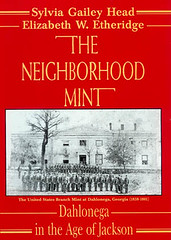 A second edition of the 1986 classic The Neighborhood Mint: Dahlonega in the Age of Jackson has been produced by Al Adams at Gold Rush Gallery, Inc. The new edition of the work by Sylvia Gailey Head and Elizabeth W. Etheridge includes new color photographs of coins produced at the Dahlonega Mint and the recently discovered photograph of the Dahlonega Mint.
A second edition of the 1986 classic The Neighborhood Mint: Dahlonega in the Age of Jackson has been produced by Al Adams at Gold Rush Gallery, Inc. The new edition of the work by Sylvia Gailey Head and Elizabeth W. Etheridge includes new color photographs of coins produced at the Dahlonega Mint and the recently discovered photograph of the Dahlonega Mint.The authors' sensitivity to historical ironies and their careful and exhausting use of rare primary source materials make this a useful book or professional historians. But it is a book for everyone to enjoy. Its compelling narrative, it development of characters, its sense of humor, its lively quotations from the correspondence of the period, and its constant attention to conflict in the community combine to make reading the book a pleasure as well as a profit.
The 234 page hardbound book is priced at $30, plus $4 shipping.
For more information, see: http://goldrushgallery.com/tnm/
NEW EDITION: FRIEDBERG'S GOLD COINS OF THE WORLD, 8TH EDITION
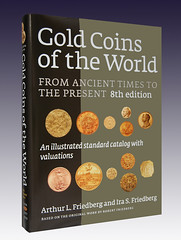 Gold, the most precious and fabled metal, the oldest form of coinage, and always an economic refuge in times of crisis, stands virtually alone today as the one investment not to have been buffeted by economic turmoil. Instead, its price has risen to new heights, surpassing even the record $850 an ounce recorded in January 1980.
Gold, the most precious and fabled metal, the oldest form of coinage, and always an economic refuge in times of crisis, stands virtually alone today as the one investment not to have been buffeted by economic turmoil. Instead, its price has risen to new heights, surpassing even the record $850 an ounce recorded in January 1980.The eighth edition of Gold Coins of the World, by Arthur and Ira Friedberg, based on the original work by the late Robert Friedberg goes far beyond gold as a commodity. It shows that even more remarkable than the rise in the gold price is the dramatic and unparalleled increase in the value of numismatic gold coins.
Collectors, as well as investors now realize the relative rarity of coins compared not only to other forms of art and antiques, but also to some other numismatic categories. So broad is the increase that it is difficult to single out any country or region.
Traditional collecting countries such as those in Western Europe have seen many prices at least double in just five years. In Eastern Europe, some Russian, Polish and Hungarian coins have increased by a factor of ten or more. The coinage of India and the Islamic Empires, long dismissed by western collectors as difficult to decipher, unimportant, and lacking in value, is now the subject of intense interest, so much so that the “Arabian Empires” section is expanded more than tenfold to accommodate the amount of information demanded by contemporary collectors.
The gold coins of the ancients, too, have risen dramatically, especially those in higher quality. In fact, as collectors recognized the scarcity of coins in the highest states of preservation, the premium for such coins relative to lower-graded ones escalated beyond traditional proportions.
When the first edition of Gold Coins of the World made its debut in 1958, it forever changed the way gold coins were collected, cataloged, traded, and priced. For the first time, one book provided a reliable guide for a subject which previously required an often expensive investment in multiple volumes of literature, some of it rare and antique, and much of it badly out-of-date.
With the publication of this pioneering work, Robert Friedberg (1912-1963) established himself as an international icon in the field of numismatic literature. The 'Friedberg Numbering System' he developed became then, and remains today, the internationally-recognized standard for systematically identifying any gold coin ever made.
From just 384 pages in 1958, Gold Coins of the World has expanded to the extent that it now contains more than triple the information of its ancestor. It still stands alone as the first and only book to describe, catalog and price two millennia of gold, platinum, and palladium coin issues from across the globe. From the first coins of the ancient Greeks to the most recently-issued modern commemoratives, the book contains an astonishing collection of more than 21,000 individual coin listings accompanied by over 8,000 actual-size photographs, some of which are only otherwise found in rare, out-of-print books.
The prices, usually in the two most commonly-encountered states of preservation, have been fully updated, for the most part raised substantially, to reflect the dynamics of today's market. Illustrations have been added or improved, and hundreds of new discoveries and recent issues are included for the first time.
Contemporary (post-1950) gold coins, which used to form their own section, are now integrated in alphabetical order with all other issues beginning in AD 600. A chart listing weights and precious metal content is included with the coins of each country.
Arthur Friedberg, recently named Honorary President of the International Association of Professional Numismatists, and Ira Friedberg, have completely revised and expanded their late father's work. They have been fortunate to have had the valuable assistance and cooperation of a who's who of the leading numismatists on every continent in bringing this edition to fruition.
For the numismatist, banker, economist, historian, or institution of higher learning, the eighth edition of Gold Coins of the World (ISBN 978-0-87184-308-1) is a book for every library, public and private. It will be available at the end of April 2009. The 11¾ by 8¼ inch (A4) hard-bound book has 800 pages and a list price of U.S.$89.95 (€75 ex VAT).
It is available from book stores, coin dealers, and from Internet book sellers. The book is also available on CD for $74.95. (ISBN: 978-087184-908-3). To order direct from the publisher (only in North America) or for more information, contact The Coin & Currency Institute, Inc. at P.O. Box 1057, Clifton, NJ 07014. Toll-free1-888-471-1441. Fax 973-471-1062. E-mail: info@GoldCoinsoftheWorld.com. Ordering information and sample pages from the book are found on the book's web site, www.GoldCoinsoftheWorld.com .

NEW BOOK: SEA SERVICE MEDALS BY FRED BORCH
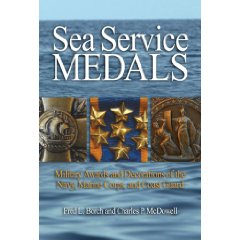 Product Description:
Product Description: About the Author:
For more information, see: Sea Service Medals: Military Awards and Decorations of the Navy, Marine Corps, and Coast Guard (www.amazon.com/gp/product/1591140897/ref=pe_5050_11848350_snp_dp)
NEW E-BOOK: COMPLETE GUIDE TO BARBER DIMES BY DAVID LAWRENCE
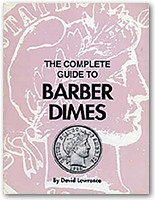 Stella Coin News (SCN) is excited to announce their latest online reference book, The Complete Guide to Barber Dimes. Originally published in 1991 by late author, David Lawrence, the ground‐breaking reference is now available to all collectors free of charge for their personal use.
Stella Coin News (SCN) is excited to announce their latest online reference book, The Complete Guide to Barber Dimes. Originally published in 1991 by late author, David Lawrence, the ground‐breaking reference is now available to all collectors free of charge for their personal use.This rare book has been out of print for some time and The Complete Guide to Barber Dimes will be useful to entire numismatic community.
You will find an in‐depth analysis and die variety study on this series, as well as relative rarity rankings. We encourage added comments and updated information on this series.
The following reference books are now available on the SCN web site to all users:
- The Complete Guide to Buffalo Nickels, 3rd edition by David Lange
- The Complete Guide to Mercury Dimes, by David Lange
- The Complete Guide to Walking Liberty Half Dollars, by Bruce Fox
- Tales from the Bourse by David Lawrence Feigenbaum
- The Complete Guide to Liberty Seated Half Dollars, by Randy Wiley and Bill Bugert
- The Complete Guide to Washington Quarters, by John Feigenbaum
- The Complete Guide to Franklin Half Dollars, by Rick Tomaska
- The Complete Guide to Barber Quarters (coming soon)
- The Complete Guide to Barber Halves (coming soon)
- The Complete Guide to Certified Barber Coinage (coming soon)
- Hobo Nickel Book (coming soon)
To access Stella Coin News, see: www.StellaCoinNews.com
REVIEW: COIN WORLD'S ONLINE EDITION
"To each his own." So writes Coin World editor Beth Deisher about the availability of the new digital version of that magazine alongside the traditional paper edition. Coin World is one of a suite of publications Amos Press has made available online. As a current subscriber I've been receiving a weekly email informing me that "Your Digital Editions Are Now Available". Conveniently, the company knows who I am; or more accurately, knows that I'm a current subscriber. Clicking on the "CLICK HERE" button in the email graphic or on any publication cover takes me directly to the online edition. None of those endless cascading menus before you get to where you really want to go here.
And it's not just Coin World that I can read. Also available are Coin Values, Worldwide Coins, Paper Money Values, the Amos Advantage Coin Product Guide, the Amos Advantage Stamp Product Guide, and Scott Stamp Monthly. Clicking on any publication cover, visible when following the email link or via the Digital Library option, opens a new window with the digital version of that publication. I will note that I view the digital magazine(s) on a 24" color-calibrated iMac with the display set at 1920 x 1200 resolution. I also use a Logitech trackball with left/right 'mouse' buttons and various scrolling options.
There are several navigation tools which make browsing easy, all displayed as icons or text in a horizontal menu bar at the top of the window. Pages can be viewed one at a time, or as a two-page layout. Moving from page to page is accomplished either by using the left/right arrows on either side of the page view, or by using forward/backward and document beginning/ending arrows, which will be familiar to Adobe PDF users. Contents, Search, and Pages options display either a clickable list or page view thumbnails that take you directly to the selected page. The table of contents page also links each heading to the first page of that article, the links indicated by a yellow highlight during mouseover.
Some advertisers are also linked in a similar manner, and clicking on a highlighted ad opens a new window displaying the company's web page. Additional functions are icons to add the Coin World link to your Favorites, Print, and "Invite a friend to view this digital edition for a limited period". I've printed both to paper and to PDF, which enables saving a digital copy to my computer or as a backup. Other navigation functions include various Zoom options, including the ability to save a desired zoom setting. Pages are readable when zoomed to full screen, two-page layout, which on my computer results in a page display that is nearly standard US letter size.
Finally, there are options to display the Amos Press Digital Library, which has thumbnail image links to all current editions; Archives, which for Coin World, Worldwide Coins, and Coin Values includes all issues back to January, 2008; a handy Renew option for renewing subscriptions (never let a marketing opportunity go to waste!); and a Help selection which describes the menu options.
The design is not perfect, but problems are few. I couldn't get a search of a phrase (for example, 'bust half dollar') to display just the occurrences of the entire phrase. Instead, Search highlights the location of any of the search words, even when 'Exact Match' is checked. The multiple zoom/navigation options are useful, but can lead you to a display view that makes you wonder "How did I get here, and how do I get back?", if you're not paying attention. Print to PDF worked great for me the first time I used it to print the whole Coin World issue, but later tries inexplicably reduced the page size (though printing just a few pages worked normally).
I like several things about Coin World online but there is one reason above all: the user interface is straightforward and easy to use, but powerful. There is no "clever" page-flipping animation, no complicated menu structure. Zoom and navigation options are comprehensive, and at maximum zoom extent there is no significant loss of text or image clarity, which is both surprising and uncommon. I can print to paper, or print (save) to an industry-standard PDF file. It's possible to search for key words, in both articles and ads, not just within the displayed issue but also in the entire collection of available issues of a particular publication. Amos Press is building a fairly extensive archive of past issues, which I hope will not only grow but be available for a long, long time. I believe this digital implementation is one of the best currently available, if not the best.
THOUGHTS ON THE MOTTO 'IN GOD IS OUR TRUST'
In response to Bill Michal's query about the origin of the motto “In God We Trust” on U.S. coins (where he was looking for documentation on an earlier phrase “In God Is Our Trust”, Arthur Shippee writes:Method: would 18th century readers have perceived "In God We Trust" and "In God Is Our Trust" as so very different? We may be more attentive to such precision than most folks then. Beware too narrow a focus.
VOCABULARY WORD: MORE ON BRUMAGEM OR BRUMMAGEM
Regarding last week's numismatic vocabulary word, Tom DeLorey writes:MORE ON THE OMAHA BANK HOARD
Mark Borckardt of Heritage Auction Galleries writes:The hoard consisted of cent through half dollar rolls all in mint state condition. Heritage bought the hoard in its entirety and it required a moving van to transport everything. The earliest coins in the hoard were original rolls of Buffalo nickels and Walking Liberty halves, with most of the coins being saved in the 1950s and 1960s, and very little saved after 1964.
Unfortunately, I can't disclose the purchase price, other than to tell you it was a seven figure deal.
MORE ON RELIC MEDALS
I am certain there are many others, but this early publication could be the embarkation platform for a research project that could easily occupy the rest of one researcher's lifetime. I believe there is that much hidden material -- in publications and the actual specimens themselves -- to indeed make this a lifelong pursuit. You would have to examine a library full of auction catalogs in many languages. Catalogers, it seems, delight in describing relic items, their inscriptions give the clue to the unusual composition such specimens are struck or cast in.
I was sitting in the waiting room this morning for my six-month eye examination and mentioned to Good Wife I wanted to reply to Don's inquiry. "Be sure to define relic medals," GW said. So for those of you who want to be up-to-speed on the numismatic meaning of "relic" terminology here goes:
Medals are ideal for relic metal use. Typical relic medals are made from captured cannon, the bronze propeller or other marine hardware from a famous ship, the metal from a bell or roof, or metal from a famous object, such as the Statue of Liberty. Bronze, iron, precious metal, space alloys have all been fashioned into relic medals.
I copied that last paragraph intact from the entry on "relic metal" from my Encyclopedia of Coin and Medal Technology. So if you want to write about it put it in your own words. Those are mine. In all I wrote a page and a half on relic items. I learned certain ancient coins were made of relic material.
Joseph Hilarius Eckhel, the father of numismatic literature (based on his 18th-century 8-volume work) was honored by a portrait medal made by Anton Scharff in 1880 Vienna struck in melted ancient coins. Perhaps this could be the keystone of such a relic medal collection (and illustrated as the frontispiece in the catalog?).
For years as I have encountered relic medals I have casually added these in a separate database and now have recorded two dozen such items, mostly American. I would be delighted to turn over this brief list to that scholar who would take on the pleasant chore of writing the book on the subject. Such a list would surely grow to more than two hundred I estimate.
There are collectors and collections of relic medals. One, dredged up from my memory of the past, was in the possession of medal dealer Hank Spangenberger. At a convention once he showed me a group of relic medals that blew my mind. I offered him a ridiculously high price if he wanted to sell them, but could not budge him. They were worth more than money to him, and I understood. (Had I owned them, I would not have sold them either.)
It seems every mint and every medalmaker has been confronted by someone who wants some item struck in relic metal. Invariably such relic metal has aged, or weathered or effected by seawater or some harsh environment to become unsuitable for striking. It is more than "work hardened" the term metal workers use. In a word it is a "bitch" to strike (casting does not present such problem).
Case in point: The firm Gold Leaf Ltd, contracted for all the scrap copper sheeting, iron supports and concrete from the Statue of Liberty when it was refurbished in 1985 under Lee Iacocca in preparation for its 100th birthday a year later. I don't know what they did with the concrete, but medals were struck in the Statue's excess copper and iron.
I can still recall the swearing of the pressman in the coining room at Medallic Art Company, which struck a couple varieties of the medals. He just could not bring up all the relief in the die in the coining process. They looked worn the instant they were struck.
Incidentally, I tried to convince the officials of Gold Leaf they were using the wrong term. They had included "authentic materials" in the inscription on all their relic items. I was unsuccessful in convincing them to use the term "made from" in which every collector is familiar - one of the reasons, to my mind at least, their venture was not profitable.
Don mentioned there are religious "relic items" as well. These include a small case, called a "reliquary," to contain a religious artifact inside (or such a locket worn about the body). It would be the cataloger's choice to include these or not. If he didn't I understand he would want to include only the more numismatic items, struck or cast.
A word for Don Cleveland: I would hope you would step forward and volunteer. Tag -- you're it! Why don't you undertake the project to compile the catalog you so much want to have?
Coin World News Editor Bill Gibbs writes:
Additional catalog listings appeared (not in Clearinghouse) in the Dec. 3, 1980, issue of Coin World. I've also written articles on a number of individual relic pieces during my time on staff. Relic medals are a fascinating series, and while I no longer actively collect them, I still have my old collection. I am sure that many relic medals have been issued since my catalogs were published, so new cataloging efforts would be welcomed by the numismatic community, if someone wants to start working on a new catalog.
MORE ON THE GREAT DEPRECIATION
In response to Dan Owens' earlier submission, last week Tom DeLorey wrote:Dave Lange writes:
Banks would not accept them for deposit at their former value, and the merchants would have no recourse but to sell them at a discount to bullion brokers. The same scenario played out again two decades later with the United States trade dollar, which lost its domestic legal tender status in 1876 at the same time as the price of silver was declining.
As for the individual who hoped to redeem his Polhemus-counterstamped pieces for their former legal value, his was a hopeless cause. Polhemus was not endorsing the coins' value in any way; he was simply using them as an advertising medium, and any court would have recognized that fact.
MISTER RED BOOK: RICHARD S. YEO
James Higby writes:They called him "Mister Red Book." But Richard Sperry Yeoman did more than just write the best-selling coin book in history. He rewrote the history of the coin collecting hobby - transforming numismatics from a pastime of the scholarly and wealthy to a passionate pursuit of ordinary, everyday Americans.
R.S. Yeoman died on Nov. 9, 1988, at the age of 84, after suffering a stroke while driving his car near his retirement home in Tucson, Ariz. But the legacy he left is a towering testimonial to the quiet dedication of his long and fruitful life.
Yeoman never regarded himself as the giant he truly was. Indeed, he seemed embarrassed by the kudos he received - and his self-effacing manner endeared him all the more to those of us who had the good fortune to know him.
Dick Yeoman would often deflect admirers' compliments by saying he'd simply been lucky - a man who merely chanced to be "in the right place at the right time." The place was the Whitman Publishing Co. in Racine, Wisconsin, and the time was 1934. Yeoman was a young sales and advertising executive and got the assignment to market a new product: an 11-by-14-inch cardboard chart with rows of holes designed to hold and display various U.S. coins by date and mint mark.
This "coin board" had been devised by a man named J.K. Post. But Yeoman was the one who promoted it and expanded it from just a novelty item to the cornerstone of what became a coin collecting industry.
In 1940, Yeoman hit upon a method of improving the basic coin board: He reduced its size, added extra pages and a flap and came up with the Whitman folder. These simple yet ingenious modifications gave the coins more protection and, at the same time, made it far easier to store them and carry them around.
Though modest about his role in developing and popularizing these products, Yeoman readily acknowledged the importance of the "penny board" in stimulating the modern coin market.
"The system of collecting by dates and mint marks made all the difference in the world," he later observed. "The idea of filling holes one by one until the collector had put together a complete set - this had tremendous impact upon the American public.
Many of the collectors created by the coin boards and folders soon became curious as to how much their coins were worth. Yeoman and Whitman satisfied that curiosity in 1942 with the first edition of the "Handbook of United States Coins," or "Blue Book," as it's almost universally known. This gave wholesale prices - the prices a collector could expect to receive for his coins from a dealer.
"A Guide Book of United States Coins" - better known as the "Red Book" - was scheduled to join the Blue Book not long afterward, this time providing retail values. But World War II delayed the book's debut for five years. When it did appear, it proved to be an even bigger seller. Both books, in fact, rank today among the all-time nonfiction best-sellers, with total combined sales in the tens of millions.
To read the complete article, see: Mister Red Book (www.pcgs.com/articles/article301.chtml)
THE BOOK BAZARRE
NUMISMATICS IN STEPHEN KING'S "SKELETON CREW"
Like many insatiable readers of a certain age, I remember devouring King's writing throughout middle school and into high school. So when I found his classic collection of short stories on a bookseller's jumbled shelves, I decided to spring the five dollars for a few hours' stroll down Memory Lane.
In the story Word Processor of the Gods, King tells about a henpecked husband who inherits a computer that can alter reality to whatever's typed onto its screen. One of his first experiments is to type MY FLOOR IS BARE EXCEPT FOR TWELVE TWENTY-DOLLAR GOLD PIECES IN A SMALL COTTON SACK.
I didn't remember that part of the story from my first (long-ago) reading, so I was curious to see how King would describe the coins.
Hmmm. There appears to be some literary license taken here, since the date is on one side of an 1871 Liberty Head $20, and the eagle on the other. Also, the eagle's "stern profile" is a relatively small part of the reverse design, so it seems incongruous to emphasize it (why not say "An eagle was embossed on one side"?). But you never know what an observer's eye will focus on.
Reading on, I learned this:
Where to begin! First of all, why would the weight of 12 identical double eagles have to be averaged? Were some oversized, and some under? Second --- well, they must have all been oversized, at four and a half ounces apiece! An actual double eagle weighs a little more than an ounce. Third, even at 4.5 ounces each, they would only contain 4.05 ounces of pure gold each, putting the bullion value around $25,000.
Later in the story, the main character considers various options as he tinkers with the computer's amazing capabilities. Here, King slips in another numismatic faux pas: "[He] was sure he could do it; it would be as easy as creating the Spanish doubloons had been."
It was fun to see coins in the writing of such a popular author, and this is in no way a criticism --- literary license is a fiction writer's prerogative, and from a practical standpoint, it's not like Skeleton Crew is a numismatic reference book. 99% of Mr. King's readers will be none the wiser, and I'm grateful that he used romantic old gold coins as the protagonist's wishful treasure instead of, say, a brand-new car or a generic "bag of money." Maybe some of his millions of fans were intrigued by the mental image of Wild West gold coins in a cotton Wells Fargo sack, and got hooked into the hobby. Stranger things have happened!
QUERY: RESEARCH ON OREGON AND OTHER STATE CENTENNIAL MEDALS SOUGHT
I have begun looking for experts specifically on the Minnesota issues and the Kansas issues. I am interested in some background information, identifying the various issues and mintages. I happen to know that each county in Kansas issued or was issued an official medal. I have also obtained one or two good-fors that bear the official symbol.
Minnesota's appear to consist almost entirely of civic organizations and private companies with an unknown but smaller number of issuing counties.
If anybody has any information about these issues that he is willing to share or, even better, would like to contribute a 2 to 4 page article with illustrations for publication would you please contact me?
I have also recruited a colleague who has agreed to contribute an article o= n US Centennial medals which he and I agree may be considered the progenitor of subsequent state centennial commemorations.
I have a go time of between 2-3 months. I expect to sell perhaps 100 copies realistically, and perhaps a hundred or so more over time. In other words this is going to be a very small project but I hope a significant one as I will be publishing the first formal catalogue of Oregon centennial medals.
I would be willing to pay any contributor the princely sum of $50 or a commensurate number of copies based on my printing costs. I have self-published a couple of other guides and find= that although the work is great, and the rewards small, it ultimately pays off in a rather difficult to describe sense of accomplishment that makes the project seem almost worthwhile.
Again, if any of you experts in either the Minnesota, Kansas or Montana centennial medals can help me please don't hesitate to contact me. My email address is bajookajo@hotmail.com. Thanks.
2009 HUDSON-FULTON CELEBRATION LACKS MEDALS
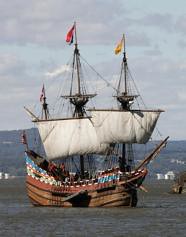 Four hundred years ago Henry Hudson sailed up the Hudson River in his ship the Halve Maen (Half Moon). Two hundred years ago, more or less, Robert Fulton used the same waters to test his new invention, his steamboat, the Claremont. One hundred years ago there was a massive celebration honoring both men, from New York City to the Catskills.
Four hundred years ago Henry Hudson sailed up the Hudson River in his ship the Halve Maen (Half Moon). Two hundred years ago, more or less, Robert Fulton used the same waters to test his new invention, his steamboat, the Claremont. One hundred years ago there was a massive celebration honoring both men, from New York City to the Catskills. This year there seems to be the opinion, "ho-hum, we've got better things to do." Not one word of any medal being issued. What a contrast to 1909. Every medal maker in New York City was humming with activity that year. Even Medallic Art Company, then only one man, Henri Weil, was working at maximum capacity.
His brother, Felix Weil was in partnership with a fellow Frenchman, Jules Edouard Roine in a sculpture shop nearby. They were modeling medals as fast as they could, supplying galvano metal patterns to both Henri down the street, and Whitehead & Hoag across the Hudson River in Newark.
There was some news this week of 2009 events being planned. The Canadians were more interested than New Yorkers. The Canadian Press listed 17 such events up and down the Hudson River from wacky raft races to tulip festivals to cemetery tours.
A replica of Hudson's ship is sailing up and down the river this year and the Albany Institute of History and Art has mounted its current exhibit: "Hudson River Panorama: 400 Years of History, Art, and Culture." It features hundreds of artworks, artifacts, interactive displays and rare documents from the institute's own collections, through Jan. 3, 2010.
The Associated Press, the New York Daily News and USA Today ran smaller stories. But thanks to our northern neighbors here is the best story: New York's Hudson Valley marks Henry Hudson's historic 1609 voyage (http://www.google.com/hostednews/canadianpress/article
/ALeqM5jOFJijSyYbNlBPUiTx816Y9-Tt3w)
MORE ON NUMISMATIC TRAINING FOR BANK TELLERS
Pete Smith writes:One day I received a call from a police officer who had been called to a suburban bank. Someone brought in some coins that didn't look right. The silver color was a little different and the coins did not have orange edges.
I explained to the officer that the composition of silver coins changed after 1964 and the earlier coins had a different composition than current coins. I also explained that we were currently paying four times face value for pre-1964 coins and we would be happy to take them off the hands of the bank.
It is tough to realize what an old geezer I am when I remember events like that from ancient history. I might have thought such information would be passed down to bank employees but apparently not.
QUERY: ANDREW AND GEORGE ZABRISKIE
Len Augsburger writes:NUMISMATIC LITERATURE AND PROJECT GUTENBERG
I really enjoy spending a couple minutes a day to proofread a few pages. You are fed one page at a time, and you compare the scan to the text produced by the software and make any changes that are needed. It is a great way to get a taste of older books (virtually all the books were published before 1923).
Many scans are taken from the big scanning operations by Google and the Internet Archive. I helped proofread the 1914 "Catalogue of coins, tokens, and medals in the numismatic collection of the Mint of the United States at Philadelphia, Pa." The e-book is not finished yet, but you can see the scans at www.archive.org/details/catalogueofcoins00unitrich .
It seems to me that some numismatically-minded volunteers might find (or produce) scans of public domain numismatic works and make them more readily accessible by getting them into Project Gutenberg. For instance, Google has scanned the 1916 volume of the Numismatist (http://books.google.com/books?id=qJUUAAAAYAAJ).
We should certainly should preserve the hard copies of numismatic works, but at the same time we can produce electronic texts so that their content is more easily accessed and preserved.
More information about the Distributed Proofreaders can be found at www.pgdp.net.
ANCIENT MANUSCRIPTS PLACED ONLINE
Unesco says the World Digital Library will help to promote curiosity and understanding across cultures.
Among the artefacts are a 1,000-year-old Japanese novel and the earliest known map to mention America by name.
The project hopes to expand access to "non-Western" items - though the largest number of items digitised so far are from Europe.
The material is drawn from about 30 libraries and archives across the world, and will be made available in English, Arabic, Chinese, French, Portuguese, Russian and Spanish.
To read the complete article, see: UN puts global treasures online (news.bbc.co.uk/2/hi/entertainment/8009974.stm)
To visit the World Digital Library, see: www.wdl.org/en/
ARTICLE PROFILES U.S. MINT DESIGNER SUSAN GAMBLE
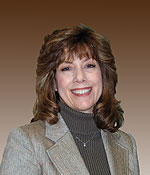 Got any Alaska, Oklahoma or Washington state quarters jingling in your pocket? Pull them out and take a good look at the handiwork of a military spouse.
Got any Alaska, Oklahoma or Washington state quarters jingling in your pocket? Pull them out and take a good look at the handiwork of a military spouse.Susan Gamble, an Air Force wife and Master Designer for the U.S. Mint, created the reverse (tails) of those spendable, collectible coins. In fact, her artwork appears on many coins, including an upcoming 2009 penny commemorating Abraham Lincoln’s presidency.
 Susan described the significance of one design, a 2007 Martha Washington coin, part of a gold commemorative series honoring presidential spouses.
Susan described the significance of one design, a 2007 Martha Washington coin, part of a gold commemorative series honoring presidential spouses."It’s the only coin I’ve done that is my tribute to all of my military wife sisters," she said from her home in San Antonio.
Her design emphasizes Mrs. Washington’s role as a military wife, depicting her sewing a button on a soldier’s uniform. An inscription reads "First Lady of the Continental Army."
"She traveled with George Washington," Susan said, "and travel wasn’t getting on a plane. It was very arduous. She went to Valley Forge."
"That’s what military spouses do," she said. "On those cold, depressing days at Valley Forge, she treated the wounded. She organized other ladies in the area. She would have been doing needlework, sewing uniforms, socks and mending."
In addition to her mint position, Susan has her own graphic design business, and her portfolio encompasses a variety of commercial and fine art.
Persistence and flexibility have bolstered her artistic success during 30 years as an Air Force wife, she said. "A lot of it is just pure one word: Tenacity. You really to have to start out from scratch every time you move."
At another intersection of Susan’s artistic and military paths, she designed the Air Force Combat Action Medal, initiated in 2007. She was invited to see the award presented to the first recipients by then Air Force Chief of Staff Gen. Michael Moseley.
"My eyes teared up when the first troops were presented their medals," Susan said. "As much as my coin work means to me, this is my military family. This is much more important emotionally to me.
"These will pass down to my children as part of a life story."
To read the complete article, see: This spouse right on the money (www.stripes.com/article.asp?section=140&article=62131)
WELSHMAN RICHARD WILLIAMS AND HIS BLACK SHEEP BANK NOTES
The man behind both ‘issuing authorities’ and their note issues was Richard Williams, a Welshman who had been employed in the banking industry for many years and who was an Associate of the Institute of Bankers. In 1968 there was some debate in Wales concerning the possibility of establishing a Bank of Wales, which would be used to promote trade and industry in the principality. While the debate carried on around him, Mr. Williams wrote to the Prime Minister of Britain asking that the name ‘Bank of Wales’ should only be used for a company that promoted the best interests of Wales. His letter passed through official channels and he received several replies. One of the replies was a letter from the Board of Trade, which stated that no company would be permitted to use the title ‘Bank of Wales’ unless they really deserved the name.
Richard Williams, as will become apparent, was not overly impressed with the bureaucratic government of his day and so he immediately devised a response to the letter from the Board of Trade. His response was to register a company with the name ‘Prif Trysorfa Cymru Limited’, with shares of £100 split between himself and his wife. The Board of Trade duly registered the company, apparently unaware that the Welsh name of the company was translated as ‘Chief Treasury of Wales Limited’.
Having embarrassed the Board of Trade, Mr. Williams then wrote to the Secretary of State for Wales, stating that it was unnecessary for the debate on the formation of the Bank of Wales to continue, as he had taken the necessary steps in establishing his company, which would look after the interests of Wales. Having taken his enterprise to this point, the next logical step was to produce some form of currency. Aware of the law and the restrictions placed on him, Mr. Williams decided to print and issue bills of exchange.
Within several months the ‘Prif Trysorfa Cymru Limited’ was issuing ‘payment orders’, which looked and worked in a manner similar to cheques. The payment orders were used to transfer money and pay bills, and they were cleared through the clearing banks just like cheques.
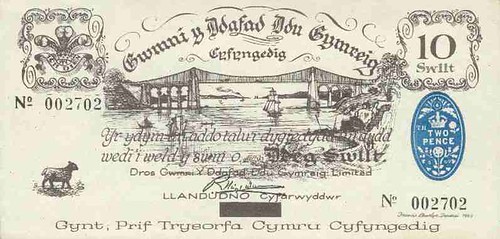
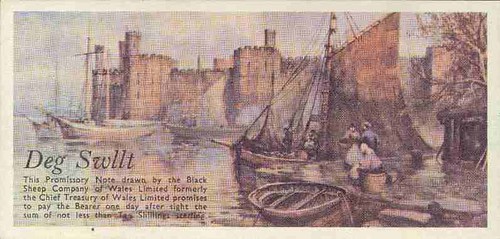
The front of each note was designed by Francis Llewelyn Traversi, a commercial artist from Llandudno, and his name is printed at the bottom left of each note along with the date ‘1969’. The drawing of the Menai Bridge is adapted from line engraving by J. W. Amrose of Bangor, which was published about 1830.
The details of the Chief Treasury of Wales and the Welsh Black Sheep Company to this point have been garnered from book by Ivor Wynne Jones called Money For All, The Story of the Welsh Pound. The book was published in May 1969 and does not complete the story of the enterprises launched by Richard Williams.
Although the book describes several other challenges undertaken by Mr. Williams, such as creating a million-pound note and trying to get his notes recognized as legitimate instruments for sterling currency, the end of his story remains untold in the book. However, it is possible to identify some of the later issues of Mr. Williams’ Black Sheep Bank.
To read the complete article, see: Private Issues – The Chief Treasury of Wales and the Black Sheep Company (www.pjsymes.com.au/articles/Private03.htm)
MORE ON DETROIT'S LOCAL CURRENCY
Loren Gatch writes: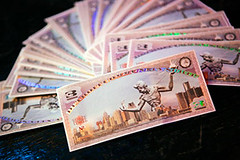 Detroit, some say, is a weird but cool blend of big city and small town. Detroit Cheers is making it weirder, smaller and cooler.
Detroit, some say, is a weird but cool blend of big city and small town. Detroit Cheers is making it weirder, smaller and cooler.Detroit Cheers is a new local currency -- the city version of exchanging grain for flour or darned socks for a loaf of bread. Only it's more like beer for pizza, or housewares for a bike tune up.
With the goal of supporting a local small economy, a trio of Detroit business owners -- John Linardos from Motor City Brewing Works, Tim Tharp from Foran's Grand Trunk Pub and Jerry Belanger from Park Bar -- have put up their own cash to back a new local currency, or scrip, called Detroit Cheers.
Put plainly, Cheers are locally issued currency accepted at select local businesses. Belanger, Tharp and Linardos each put up $1,500 to back the $4,500 worth of Cheers in circulation. The backing money is held in reserve at a bank. As backers are added, they'll release more Cheers. So one Cheers equals one dollar. "It's as good as the U.S. dollar … ironically, it's no better," Belanger says
Belanger admits that the Cheers roll-out, while enthusiastic, hasn't been flawless. "We've been overwhelmed with the response, with people who want to use Cheers -- almost too much," says Belanger. "It's been bad in a good way or good in a bad way."
One issue has been with the paper that Cheers was printed on. The trio of backers chose a cotton rag paper for durability, and bought a ream of it -- no cheap purchase. Then they had to print the stuff.
"In keeping with spirit of the whole idea, we could have gone to a printer from out-of-state that has already done this for other municipalities, where we wouldn’t have had the learning curve," says Belanger. "But that would have been kind of contrary to our sustainability, local thing -- so we're going through a learning curve."
The worst-case scenario that Belanger fears is having to completely reissue the scrip. "To have that expense all over again ... it's not always just roses!"
To read the complete article, see: 3 Cheers for Detroit's Local Currency (www.modeldmedia.com/features/detroitcheers18809.aspx)
DOG'S 1945 DICKIN MEDAL SOLD AT AUCTION
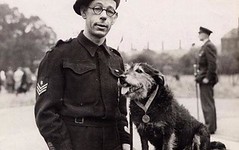 A medal for gallantry awarded to a stray dog who helped recover victims from the rubble of the Blitz fetched £24,250 at auction.
A medal for gallantry awarded to a stray dog who helped recover victims from the rubble of the Blitz fetched £24,250 at auction.The mongrel, called Rip, was awarded a Dickin Medal in 1945 after sniffing out dozens of air raid victims during the blitz.
The founder of veterinary charity PDSA, Maria Dickin, began awarding the medals in 1943 to recognise animals which showed "conspicuous gallantry and devotion to duty".
Rip was found homeless and starving after an air raid in 1940.
An air raid warden working at Southill Street Air Raid Patrol in Poplar, east London, adopted the dog and Rip began sniffing out people trapped in the rubble.
The warden found the dog, which had no official training, was always on duty, never got in the way and was quick to locate casualties.
During the Blitz he helped to find and rescue more than 100 air raid victims.
Rip wore the Dickin Medal on his collar for the rest of his life.
He died in 1948 and was the first of 12 "supreme animal heroes" to be buried in the PDSA cemetery in Ilford, Essex.
To read the complete article, see:
(www.telegraph.co.uk/news/uknews/5216457/
Gallantry-medal-given-to-dog-in-Second-World-War-sells-for-24000.html)
A DOG NAMED BANKNOTE
Here's another dog with a medal. Perhaps inspired by the Horse named Numismatist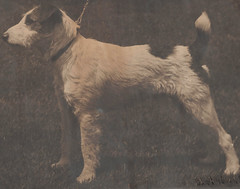 Geoffrey Bell writes:
Geoffrey Bell writes: 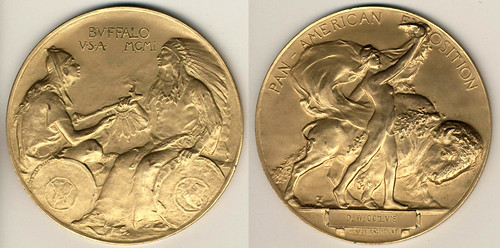
On a different subject Geoff adds:
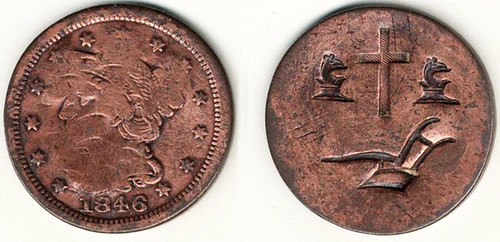
THIEVES ROB BANK OF FAKE MONEY
 Three criminals were caught in Barranquilla Saturday after they had robbed a local bank of what later proved to be false money.
Three criminals were caught in Barranquilla Saturday after they had robbed a local bank of what later proved to be false money.Police was able to arrest the three after the motorcycles they were riding bumped into each other and crashed.
Severely injured they were taken to a local hospital where the police told them that the money they had stolen was not worth the four million the thieves thought it was, but instead counterfeit money used by the bank to train their employees.
The bankrobbers have to stay in hospital for a considerable time, before taken to court.
To read the complete article, see: Thieves rob bank of false money (colombiareports.com/colombia-news-lite/97-news/
3668-thieves-rob-bank-of-false-money.html)
FEATURED WEB PAGE: HOW TO PACK BOOKS
This week's Featured Web page is John Bergman's How to Pack Books article on the NBS web site. It is a MUST for bibliophiles. Don't ship a book without reviewing this first.wiki.coinbooks.org/index.php/How_to_Pack_Books
